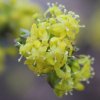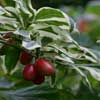|
|
|
| Cornus mas | Cornus mas
'Aureoelegantissima' (= 'Elegantissima' ) This form has brightly coloured leaves variegated pink, yellow and green. It also seems to be found under a multitude of names, but this I believe to be the current official one. It is a weak grower by comparison with most of our other forms. This tends to result in it becoming a mound of rather tangled thin branches, rather than developing an attractive structure. The flowers are also rather dull, so we no longer propagate it. |
|
|
|
| Cornus mas 'Elegant' | |
|
|
|
| Cornus mas
'Flava' Distinguished from its peers by rich golden fruit (instead of the usual red). |
|
|
|
|
 |
Cornus mas
'Golden Glory' Deep green leaves and very prolific flowering much younger than is possible from a seedling. Large red fruits. It has very deservedly been promoted to AGM status. It is indeed a great plant, being reliable and easy to grow. 3m |
|
|
|
| Cornus mas 'Hillier's Upright' | |
|
|
|
| Cornus mas
'Jolico' This German form was selected for commercial fruit production. Regretfully I don't currently have time to make full use of them. Nevertheless, it is also a fantastic ornamental, since masses of large vivid red berries from mid summer follow the lovely yellow flowers of February. |
|
|
|
|
| Cornus mas 'Kasanlak' | |
|
|
|
 |
Cornus mas
'Pioneer' I particularly like this cultivar which is distinguished by its bright red pear-shaped fruit. |
|
|
|
| Cornus mas
'Redstone' An American selection for heavy fruit production. |
|
|
|
|
 |
Cornus mas
'Variegata' My favourite of the group, with broad white margins to the leaves. They contrast superbly with the large bright red berries. An excellent plant for year round interest. Eventually it will make a small tree, but it is better grown as a shrub. |
|
|
|
| Cornus mas x officinalis | Cornus
mas x officinalis An interesting and attractive hybrid between these extremely closely related species which were kindly sent to us by Mark Weathington of the JCRA. |
|
|
|
| Cornus officinalis | Cornus officinalis 'Robin's Pride' |
|
|
|
 |
Cornus
officinalis 'Spring Glow' Previously attributed to Cornus mas, this splendid cultivar is actually a selection of C. officinalis. The most useful visual difference is that C. officinalis with maturity develops attractive exfoliating bark. The late J. C. Raulston introduced this one. As a species, this group flowers best after a cold winter, but this one requires less cold, so is great in warmer climes. See it in our Winter Garden. |